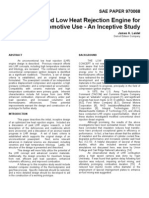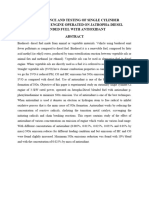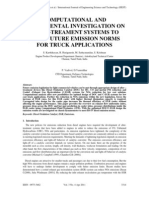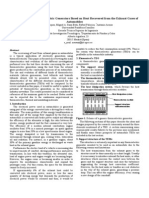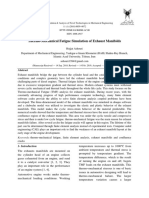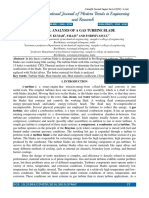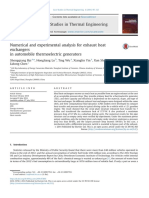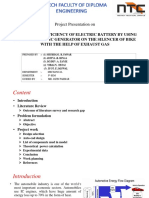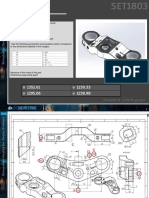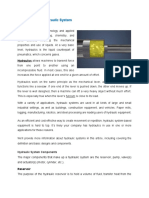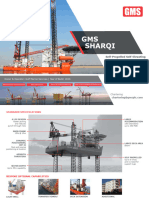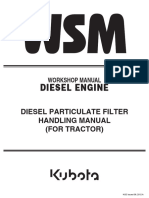315264ijsetr3997 165
315264ijsetr3997 165
Uploaded by
Vivek JadhavCopyright:
Available Formats
315264ijsetr3997 165
315264ijsetr3997 165
Uploaded by
Vivek JadhavOriginal Title
Copyright
Available Formats
Share this document
Did you find this document useful?
Is this content inappropriate?
Copyright:
Available Formats
315264ijsetr3997 165
315264ijsetr3997 165
Uploaded by
Vivek JadhavCopyright:
Available Formats
ISSN 2319-8885
Vol.04,Issue.05
February-2015,
Pages:0934-0938
www.ijsetr.com
Structural and Thermal Analysis of Conventional and Air Gap
Insulated Piston for Low Heat-Rejection Engines
PAVANI KUMARI1, DR.SUNEEL DONTHAMSETTY2
1
PG Scholar, Dept of Mechanical Engineering, Narasaraopeta Engineering College, Narasaraopeta, AP, India.
2
Professor & Head, Dept of Mechanical Engineering, Narasaraopeta Engineering College, Narasaraopeta, AP, India.
Abstract: The role of insulated piston in low heat rejection engines is significant. In this paper simulation of conventional
piston as well as air gap insulated piston is proposed, designed, simulated and modeled. A comparative study basing on various
reports is performed. Ansys tool is used to effectively model the proposed model. The multiphysics tool is embedded with
efficient CAD tool using which are the designs are modeled. Once the multiphysics conditions are implemented, various reports
are generated.
Keywords: LHR; CAD; Piston; Airgap.
I. INTRODUCTION increased exhaust energy into shaft work using the
The subject of Low Heat-Rejection Engines (LHR turbocharged system. A large number of studies on
Engine) has been given considerable attention recently as performance, structure and durability of the LHR engine
engine builders struggle to find remaining avenues to [11-14] have been carried out and presented a new concept
improve economy and lower emissions [1-5]. Cooling an of the LHR engine combined with the turbo compound
engine is a “necessary evil” which designer would gladly system. Although promising the results of the investigations
forego if it were possible. But local hot spots, high cost of have been somewhat mixed. Most have concluded that
materials able to survive at elevated temperatures, and insulation reduces heat transfer, improves thermal
lubrication problems generally have prevented elimination efficiency, and increases energy availability in the exhaust.
of the cooling system. Beyond the complication of a cooling However contrary to the above expectations some
system, there is the knowledge that is sizable fraction of the experimental studies have indicated almost no improvement
energy input to the engine is simply being thrown away. In in thermal efficiency and claim that exhaust emissions
today’s fuel economy conscious setting it is natural that deteriorated as compared to those of the conventional water-
ways are being sought to effect a double benefit in which cooled engines.
cooling system can be dispensed with and, at the same time,
more of the input energy put to work. Energy conservation II. LITERATURE SURVEY
and efficiency have always been the quest of engineers Cole. R.M. et al [2] (1985) he made an air gap insulated
concerned with internal combustion engines. The diesel piston designed for reduced heat loss was evaluated by
engine generally offers better fuel economy than its examining its influence on the coolant heat rejection, engine
counterpart petrol engine. Even the diesel engine rejects performance and exhaust emissions of a single-cylinder
about two thirds of the heat energy of the fuel, one-third to divided chamber diesel engine. At 1000 and 1500 r/min
the coolant, and one third to the exhaust, leaving only about engine speed, use of the low-heat rejection (LHR) piston
one-third as useful power output. Theoretically if the heat resulted in a reduction in total coolant heat rejection ranging
rejected could be reduced, then the thermal efficiency would from 3% at light load to 5-7% at full load, in general
be improved, at least up to the limit set by the second law of reduction in hydrocarbon, carbon monoxide and smoke
thermodynamics. Low Heat Rejection engines aim to do this emissions, in an increase in oxides of nitrogen, and in
by reducing the heat lost to the coolant. significant improvement in brake specific fuel consumption
only at light loads. It was estimated that the LHR piston
The diesel engine with its combustion chamber walls design reduced the piston crown surface heat transfer by an
insulated by ceramics is referred to as Low Heat- Rejection amount equivalent to from 3.5% (full load) to 5.5% (light
(LHR) engine [6-10]. The LHR engine has been conceived load) of the input fuel energy at 1000 r/min. Daniel C. Oren
basically to improve fuel economy by eliminating the et al [3] (1996) the Data has been gathered to compare the
conventional cooling system and converting part of the performance of steel crown pistons coated with yttria
Copyright @ 2015 IJSETR. All rights reserved.
PAVANI KUMARI, DR.SUNEEL DONTHAMSETTY
stabilized zirconia or mullite to an uncoated piston. The conductivity titanium alloy type 6242 structural material and
effect of coated pistons on in-cylinder heat transfer was 1.25 mm thick slurry densified thermal barrier coating. The
determined from curves of ISFC versus centroid of heat piston material, structural configuration, and detail design
release. Error analysis o the measurements showed features were selected through computer aided modeling
uncertainty of ± 3% in ISFC and ± 2% crank angle degrees and qualified through small-bore engine testing.
in the centroid of heat release could be expected for the
data. Particulate emissions increased at advanced injection Screening of plasma sprayed thermal barrier coatings
timings with the mullite coated piston while the zirconia was performed on a simple thermal test rig and final
coated piston showed an increase in particulate and NO x at selection of a system was made through small-bore engine
advanced timings. testing. Michael Winship et al (1993) [7] company has
established a strong reputation in the application of the
You Zhang Shanghai et al [4] (1998) for a vehicle engine, Finite Element Method to pistons and has continued to build
the piston is the essential part that bears heavy mechanical on this experience, in order to satisfy market needs with
and thermal loads; therefore it has very nearly influences on respect to increased product durability and reduced
the reliability and durability of an engine. So the piston development lead times. Results are presented in this paper
greatly hire less the increase of power gas engine. So far for gasoline and diesel pistons to illustrate the methodology
high powered heavy loaded vehicle engines using the LHR currently used and the direction in which future piston
piston is an effective way to enhance the piston’s technology is moving. Parker. D.A. et al (1987) [8] the
performance of enduring thermal loads and reducing heat concept of an air gap insulated piston has been explored
rejection. This paper presents the study of the LHR piston using bolted and welded/roll banded designs. Pistons with
and its structure. The three dimensional FEA of the piston bolted on crowns demonstrated the effectiveness of air gap
was offered, its mechanical and thermal loads were insulation, but roll bonded and weld designs were found to
calculated and a large amount of useful data was obtained. be more robust and to provide the complete sealing of the
K. Kumarasekaran et al (1994) made a novel design of an air gap necessary for continued insulation.
air gap insulated piston has been proposed which is
expected to give a larger life compared to the existing Evolution of the design to combine high insulation with
designs. The new composite piston is made of a crown piece adequate durability is discussed. Engine running times of up
which is fitted to the base of a piston through a gasket by an to 200 hours at full load have been achieved for an air gap
interference fitting and locked by oral shaped riveted piston which reduces heat flow to the crown by 33%. An
radially. A steady state two dimensional thermal analysis is improved design giving 41% reduction of heat flow has
performed on the piston to predict the temperature been tested for 78 hours at full engine load with no evident
distribution, and then a thermo elastic analysis is performed deterioration. Development is continuing to provide a fully
to obtain thermal stress distribution. Further, a pure durable piston achieving up to 50% reduction in heat flow.
mechanical stress analysis is performed on the piston. These Veshagh .A et al (1995) his work was carried out as a part
analyses are performed on an aluminum single piece piston of a European project coordinated by Daimler Benz. The
as reference and an air gap insulated ultra high strength steel aim of this research program was to reduce HC emission of
piston using FEM. a petrol engine by using a newly designed carbon piston.
The Mercedes Benz maid series four valve petrol engine
Constant temperatures are assumed at gas, liner and oil was used as a demonstration engine. A number of the FEA
boundaries of the piston. Also, film coefficients on the were carried out to predict thermal and mechanical stress
piston boundaries are kept constant. The analysis gives a analysis in the piston and optimize it shape. The original
detailed study on the temperature distribution in the piston design of the piston was fully analyzed under full load &
and heat flux through different surfaces of the piston. Also, maximum torque conditions. Results show two critical areas
piston skirt deflection and stress around the air gap area are in the piston with very high stresses and very safety factors.
obtained from the same analysis. In the steel piston, the A parametric study of various design features, dimensions
crown temperature is increased by 59% and heat loss was conducted to strengthen the design and improve its
through the crown is reduced to 24.4% compared to the safety.
aluminum piston. The maximum skirt deflection for the
steel piston is on the top about 0.39mm. The weakest Several features of the original design such as the crown
section is the top curve of the air gap. Melvin Woods et al thickness and pinhole profile were modified to reduce
(1990) [6] made an highly effective thermal insulating stresses in the critical areas of the piston. As the result of
piston concept with high projected durability characteristics this work the overall design of the carbon piston was
has been developed by means of computer aided modeling, optimized and its structural integrity and safety factor were
thermal rig bench screening, and small-bore engine testing. improved. Sunil Kumar Reddy (2009) alcohols is being
The piston concept is composed of a relatively low thermal exploited in developing the insulated engine (IE) which
reduces the ignition delay and aids combustion. Now- day’s
International Journal of Scientific Engineering and Technology Research
Volume.04, IssueNo.05, February-2015, Pages: 0934-0938
Structural and Thermal Analysis of Conventional and Air Gap Insulated Piston for Low Heat-Rejection Engines
extensive research is going on not only for finding the later can operate at normal, or even reduced, temperature
suitable alternate fuel to diesel but also for improving the relative to an insulated piston.
engine thermal efficiency. Even the most efficient diesel 1. Bolted Design of Air Gap Insulated Piston
engine rejects two-thirds of the heat energy of the fuel, one- 2. Welded and Roll Bonded Air Gap Insulated Piston
third to the coolant, and another one-third to the exhaust,
converting only about one third into useful work. By 1. Bolted Design of Air Gap Insulated Piston: The first air
reducing the lost energy and eliminating the need for a gap pistons evaluated used a simple bolted construction as
conventional cooling system, this engine system will providing the most rapid route to engine testing. Although,
dramatically improve overall performance. One of the some durability problems were experienced, the design was
methods adopted to achieve this is with for an Insulated very effective in providing crown insulation; oxidation of
engine. the crown piece indicated a temperature around 600 º C. The
secondary air gap provided by the spacer channel section
III. PROPOSED SYSTEM AND METHODOLOGY spacer was found to be crucial for insulation of the ring belt.
The main objective is to increase the engine efficiency, The use of a visco-elastic seal underneath this channel
and performance, of the individual surface areas of the section was found to be necessary to prevent the ingress of
combustion chamber of an engine, the piston offers an debris from combustion, which caused a rapid loss of
attractive area for insulation because a large portion of the insulation.
total combustion chamber surface heat transfer occurs
through this area. The study from earlier research on the
engine says about 50% of heat rejection occurs in the liner
cooling zone, to which the largest contributor is the piston.
Hence in this work, heat rejection on piston will be studied,
i.e. heat lost on the piston to be prevented. In this work,
piston insulation taken as major area. On this, heat loss due
to conduction on the piston to be prevented. Hence the
performance of engine has to be improved. Piston thermal
analysis will be carried out to achieve the above. To achieve
the above problem definition, i.e. rejection of heat loss on
the piston can be obtained by two methods,
On piston crown ceramic costing
Air insulation on Piston
Air gap insulated pistons are generally used in diesel
engines to keep the combustion chamber at optimum high Fig.1. (a) Conventional and (b)Airgap Piston.
temperature. The air gap in between piston crown and piston
2. Welded and Roll Bonded Air Gap Insulated Piston: A
body has low thermal conductivity. Due to this, the
section through the welded and roll bonded air gap piston
temperature in the piston crown is high, when compared to
developed in order to eliminate the bolts used in earlier
conventional piston. Due to this surface temperature of the
designs, electron beam welding is employed to join the
combustion chamber is very high, the air inducted into the
ferrous crown piece to the aluminum-silicon body. The key
combustion chamber is rapidly exposed to high temperature
to the development lay in the means by which this was
and it is more than the conventional piston.
achieved, namely the use of a roll bonded washer
manufactured from bearing strip as an intermediate member.
IV. AIRGAP PISTONS
The air gap piston has a conventional skirt and ring pack In such strip steel is used as a backing member and
together with a crown piece whose contact with the piston aluminum-silicon is one of the favoured bearing alloys. The
body is arranged to provide adequate mechanical strength actual roll bonding process involves both pressure and
with the minimum of conductive heat transfer. At relatively sufficient deformation of the aluminum alloy to remove
low temperatures, heat transmission across the air gap is oxides from its surface. It is the presence and very rapid
controlled by conduction and convection at a very low level. formation of this oxide that makes aluminum alloy a
However, as the temperature of the crown rises, radiative particularly difficult material to join. It was relatively
heat transfer becomes predominant, and in the most straight forward to electron beam weld the ferrous part of
advanced designs special precautions have to be taken to the roll bonded washer to the crown piece and the
minimize this. From the operational viewpoint the location aluminum-silicon alloy part of the washer to the piston
of the principal insulating region in the piston is very body. The welded and roll bonded air gap piston thus keeps
important as shown in Fig.1. According to the principles set the essential features of the bolted design, whilst eliminating
out. If the insulation can be situated above the ring pack the inherent weakness. However there, is a further
International Journal of Scientific Engineering and Technology Research
Volume.04, IssueNo.05, February-2015, Pages: 0934-0938
PAVANI KUMARI, DR.SUNEEL DONTHAMSETTY
advantage in the welded design since a vacuum is required
for operation of electron beam and these remains in the
cavities on removal from the welding machine.
A. Advantages of Air Gap Insulated Piston
When the air is inducted to the combustion chamber its
temperature is raised because of the average temperature of
the combustion chamber is raised. Due to this the fuel which
is injected in to the combustion chamber attains the self
ignition temperature quickly and so the combustion occurs
smoothly. The pressure rise in the uncontrolled combustion
is very less and the maximum temperature of the cycle is
comparatively less. The complete burning of fuel occurs
smoothly in the controlled phase.
V. SIMULATION RESULTS
Results pertaining to the meshing of the designed
structure and thermal analysis are presented in this section Fig.4. Thermal Analysis of Conventional Piston.
from Fig.2 through Fig.5. Fig.2 and Fig.3 shows the
meshing of the designed structure. Fig.4 and Fig.5 are the
thermal analysis representation.
Fig.5. Thermal Analysis of Airgap Piston.
TABLE I: Comparison of Conventional and Airgap
Piston
Fig.2. Meshing of Convenetional.
To reduce the above limitation, Insulation to the engine
component was carried out, mainly for piston. Air Gap
insulation was introduced in to the piston which is shown in
Fig.5.4 to reduce the heat loss from crown of a piston. So air
gap insulated pistons were modeled with different piston
Fig.3. Meshing of Conventional. crown materials and undergo for a Thermal analysis and
International Journal of Scientific Engineering and Technology Research
Volume.04, IssueNo.05, February-2015, Pages: 0934-0938
Structural and Thermal Analysis of Conventional and Air Gap Insulated Piston for Low Heat-Rejection Engines
Structural Analysis. Based on the result, the heat loss was [5]Sastri.Y.B. and Kumarasekaran (1994), “Thermal Stress
much more lesser while increasing the air gap and the best Analysis of A Novel Air Gap Insulated Piston”. SAE –
air gap was 1mm air gap insulated piston which is possible 941069.
in machining other size of air gap is not possible to do [6]Melvin Woods, Paul Glance and Ernest Schwarz (1990),
because the thickness of the top solid piece will be reduces “Advanced Insulated Titanium Piston for Adiabatic
which will damaged while operation is carried out in engine. Engine”. SAE – 900623.
As per thermal analysis the air gap insulated piston with [7]Michael Winship and William J. Morgan (1993),
Aluminum crown, the temperature above the crown will “PISTON DESIGNS FOR THE 90’S”. SAE – 930273.
increased by 31.27% , where as using the Stainless Steel [8]D.A.Parker and G.M.Donnison (1987), “Development of
an Air Gap Insulated Piston”. SAE – 870652.
crown, the temperature above the crown will increased by
[9]Shoran.R.Frisch, Cummins engine co (1988) “Analysis
35.34% using a 1mm air gap insulated piston. The structural
of a Heavy Duty Diesel Piston including Material, Air gap
analysis of an air gap insulated piston is compared with the
and Thermal Barrier Coating Effects”. SAE – 880671.
conventional piston is satisfactory. Though the deviation is [10] Venhash.A and C. Chen, University of Warwick (1995)
less, the increase in the rigidity of the piston structure. “Stress Analysis and Design Optimization of Carbon
Mechanical stresses due to gas pressure were modeled by Piston”. SAE – 950935.
applying a peak cylinder pressure of 88 bar to the top [11]Design Data Book – P.S.G Technology.
surface of the piston crown. This enabled the required [12]Carl. T. F. Ross “Advanced Applied Finite Element
thickness of the crown piece to be determined. The Methods”, Horwood Publishing, Chichester in 1998.
maximum stress in the aluminum was 1.31 x 10 3 N/mm2 and [13]Automotive hand Book, 5th edition, MICO BOSCH,
maximum stress in the stainless steel was 1.39 x 10 3 N/mm2. SAE International 2000.
As per the result the 1mm air gap insulated piston with [14]K.K. Ramalingam, Internal Combustion Engine, SCI
aluminum and stainless steel crown piston was machined as Tech Publications (India) PT. Ltd.
mentioned in chapter 7 and assembled in the engine.
V.CONCLUSION
The thermal analysis on air gap insulated piston shows,
that the temperature is maintained high above the crown
with very less amount of heat getting transmitted down than
a conventional piston. Further, analysis using ANSYS
software shows that by changing the material of piston
crown will increases the insulation property of the air gap.
The average temperature of the combustion chamber is
raised by 35. 97% for Stainless Steel and 32.09% for
aluminum piston based on the software result than
conventional piston. The structural analysis on air gap
insulated piston is compared with the conventional piston
and the results are satisfactory. Even though the deviation is
less, it increases the rigidity of the piston structure. An
optimum air gap thickness has been designed for maximum
insulation without sacrificing the structural rigidity.
VI. REFERENCES
[1]Beg.R.A, P.K.Bose, Jadavpur Univ and B.B.Ghoshi,
T.Kr. Banerjee and A.Kr.Ghosh, IIT Kharagpur (1997)
“Experimental Investigation on Some Performance
Parameters of a Diesel Engine Using Ceramic Coating On
The Top Of the Piston”. SAE – 970207.
[2]R.M.Cole and A.C.Akildas (1985), “Evaluation of Air
Gap Insulated Piston in A Divided Chamber Diesel
Engine”. SAE – 850359.
[3]Dale R.Tree, Daniel C. Oren, Thomas M. Yonushonis
and Paul D. Wiczynski (1996), “Experimental
Measurements on the Effects of Insulated Pistons on Engine
Performance and Heat Transfer” SAE – 960317.
[4]You Zhang Shanghai Jiao Tong University, Yong Zhang
and Bin Gao (1998), “Structural Design And FEA Of LHR
Piston For Vehicle Engines”. SAE -981488.
International Journal of Scientific Engineering and Technology Research
Volume.04, IssueNo.05, February-2015, Pages: 0934-0938
You might also like
- Radial Engine Solidworks 00 PDFDocument42 pagesRadial Engine Solidworks 00 PDFOscar Osorno67% (6)
- User's Manual 400D - ENDocument90 pagesUser's Manual 400D - ENBruno MarianoNo ratings yet
- Caracteristicas 301.6C & 301.8CDocument12 pagesCaracteristicas 301.6C & 301.8COscarNo ratings yet
- Vol.2 General Specification of ZJ50D RigDocument57 pagesVol.2 General Specification of ZJ50D Rigwaleed100% (2)
- Application of Ceramic Coating For Combustion Chamber Equipments of IC Engine: A ReviewDocument5 pagesApplication of Ceramic Coating For Combustion Chamber Equipments of IC Engine: A ReviewRobert MihaiNo ratings yet
- Long Term Continuous Use of Auto-Lpg Causes Thermal Pitting in Automotive S. I. Engine PartsDocument5 pagesLong Term Continuous Use of Auto-Lpg Causes Thermal Pitting in Automotive S. I. Engine Partsmanit1963No ratings yet
- Low Heat Rejection EngineDocument9 pagesLow Heat Rejection EnginePradheep SathyamurthyNo ratings yet
- Performance Evaluation of Alcohol in An Insulated Di Diesel Engine With Various Piston InsertsDocument9 pagesPerformance Evaluation of Alcohol in An Insulated Di Diesel Engine With Various Piston InsertsInternational Journal of Application or Innovation in Engineering & ManagementNo ratings yet
- Literature SurveyDocument2 pagesLiterature SurveygmailNo ratings yet
- IJRPR6657Document6 pagesIJRPR6657edyNo ratings yet
- Design Analysis of Cooling Fins For Two Wheeler Using ANSYS: Chinnu - Samy80@yahoo - Co.inDocument6 pagesDesign Analysis of Cooling Fins For Two Wheeler Using ANSYS: Chinnu - Samy80@yahoo - Co.inFilip SkultetyNo ratings yet
- Design Engineering: Design and Thermal Analysis of Ic Engine Fins With Different Cross-Sectional FinsDocument12 pagesDesign Engineering: Design and Thermal Analysis of Ic Engine Fins With Different Cross-Sectional FinsVinay LuckiíNo ratings yet
- Thermal Abstracts-1Document7 pagesThermal Abstracts-1innovative VijayawadaNo ratings yet
- Sai Chaitanya PDFDocument8 pagesSai Chaitanya PDFasdfNo ratings yet
- Ijte 05 01 005Document11 pagesIjte 05 01 005toancaocapa31No ratings yet
- Thermal Barrier Coating System For Internal CombusDocument13 pagesThermal Barrier Coating System For Internal Combusbaja2011No ratings yet
- CFD of Exahust ValveDocument7 pagesCFD of Exahust ValveMuhammad Imran KhanNo ratings yet
- Flow Analysis of Gas Turbine Blade For Optimum CoolingDocument8 pagesFlow Analysis of Gas Turbine Blade For Optimum CoolingijsretNo ratings yet
- Page1 JPE671 Proofr2 PDFDocument1 pagePage1 JPE671 Proofr2 PDFRochdi ZaaNo ratings yet
- Research Paper On Gas TurbineDocument8 pagesResearch Paper On Gas Turbinegz8jpg31100% (1)
- Uniformity Index - Catalytical Converter-TestDocument13 pagesUniformity Index - Catalytical Converter-Testjeetendra222523No ratings yet
- A Literature Review On The Performance Analysis of 4 Stroke Diesel Engines With Ceramic Coating Material-36993 PDFDocument7 pagesA Literature Review On The Performance Analysis of 4 Stroke Diesel Engines With Ceramic Coating Material-36993 PDFShiva ShankarNo ratings yet
- Environmental Risk of Particulate and Soluble Platinum Group Elements Released From Gasoline and Diesel Engine Catalytic ConvertersDocument5 pagesEnvironmental Risk of Particulate and Soluble Platinum Group Elements Released From Gasoline and Diesel Engine Catalytic ConvertersMuhammad AbubakarNo ratings yet
- Ej14839 PDFDocument9 pagesEj14839 PDFChandra SekarNo ratings yet
- Process Heating, Power and IncinerationDocument1 pageProcess Heating, Power and Incinerationaliscribd46No ratings yet
- Development of A Gamma Type Stirling Engine With Double Power PistonDocument7 pagesDevelopment of A Gamma Type Stirling Engine With Double Power PistonKarim GilaniNo ratings yet
- IIPaperDocument11 pagesIIPaperPunit ShindeNo ratings yet
- Fea Analysis and Experimental Investigation of Ceramic Coating On Aluminium Piston Material by Plasma Spray CoatingDocument10 pagesFea Analysis and Experimental Investigation of Ceramic Coating On Aluminium Piston Material by Plasma Spray Coatingvikky coolNo ratings yet
- Evaluation of Performance and Emission Characteristics of Turbocharged Diesel Engine With Mullite As Thermal Barrier CoatingDocument7 pagesEvaluation of Performance and Emission Characteristics of Turbocharged Diesel Engine With Mullite As Thermal Barrier CoatingRanjit RajendranNo ratings yet
- A Literature Review On The Performance Analysis of 4 Stroke Diesel Engines With Ceramic Coating Material-36993Document7 pagesA Literature Review On The Performance Analysis of 4 Stroke Diesel Engines With Ceramic Coating Material-36993ARUN VNo ratings yet
- Chamber Contour Design and Compression Flow Calculations of Rotary EngineDocument16 pagesChamber Contour Design and Compression Flow Calculations of Rotary Enginecata_alex_muntNo ratings yet
- Design and Analysis of Engine FinsDocument6 pagesDesign and Analysis of Engine FinsAJAYNo ratings yet
- SimulationDocument14 pagesSimulationram shyamNo ratings yet
- Case AnalysisDocument3 pagesCase AnalysisHazel AdoNo ratings yet
- Bioconf Fies2020 00078Document5 pagesBioconf Fies2020 00078jayrfavila45No ratings yet
- NaveenDocument15 pagesNaveenNaveenprakashNo ratings yet
- IJCRT2310057Document13 pagesIJCRT2310057Deniz AtmacaNo ratings yet
- An experimental study on the development of a β-type Stirling engine for low and moderate temperature heat sourcesDocument6 pagesAn experimental study on the development of a β-type Stirling engine for low and moderate temperature heat sourcesAbdul RehmanNo ratings yet
- FEA Analysis and Experimental Investigation of The Ceramic Coating On Aluminum PistonDocument14 pagesFEA Analysis and Experimental Investigation of The Ceramic Coating On Aluminum PistonIJRASETPublicationsNo ratings yet
- 10 1016@j Applthermaleng 2017 05 169Document19 pages10 1016@j Applthermaleng 2017 05 169FlavioEdu6695No ratings yet
- Plasma Spray Coating On PistonDocument45 pagesPlasma Spray Coating On Pistonrajkiran_rajNo ratings yet
- Paper 5503Document20 pagesPaper 5503ds8123395No ratings yet
- Nasa 1977 TBC FT50 ProgramDocument60 pagesNasa 1977 TBC FT50 Programatfrost4638100% (1)
- Thermal Analysis of A Gas Turbine BladeDocument13 pagesThermal Analysis of A Gas Turbine Blademanufacturing Tech airfieldNo ratings yet
- Mechanical Properties Material and Desig PDFDocument7 pagesMechanical Properties Material and Desig PDFFida HussainNo ratings yet
- Experimental Investigations On The Performance and Emissoin CharacteristicsDocument6 pagesExperimental Investigations On The Performance and Emissoin CharacteristicsIAEME PublicationNo ratings yet
- 1 s2.0 S1359431102000406 Main PDFDocument13 pages1 s2.0 S1359431102000406 Main PDFEderNo ratings yet
- Major Project Phase IDocument11 pagesMajor Project Phase IPreetham SaiNo ratings yet
- Numerical and Experimental Analysis For Exhaust Heat Exchangers in Automobile Thermoelectric GeneratorsDocument14 pagesNumerical and Experimental Analysis For Exhaust Heat Exchangers in Automobile Thermoelectric GeneratorsANAND V VNo ratings yet
- Performance Analysis in Off Design Condition of Gas Trbine Air Bottoming Combined SystemDocument10 pagesPerformance Analysis in Off Design Condition of Gas Trbine Air Bottoming Combined SystemIrving Rosas JovenNo ratings yet
- Projeect PPT-1Document28 pagesProjeect PPT-1Shubham PawarNo ratings yet
- Development of The Copper Motor RotorDocument13 pagesDevelopment of The Copper Motor RotorIjabiNo ratings yet
- Projeect PPT-1Document28 pagesProjeect PPT-1Shubham PawarNo ratings yet
- Experimental Investigation of Coasting On Piston by Thermal Torch MethodDocument31 pagesExperimental Investigation of Coasting On Piston by Thermal Torch MethodĐįñêśh ĎkNo ratings yet
- Gas Engines Prechamber Vs OpenDocument13 pagesGas Engines Prechamber Vs Openvictor.ciprianiNo ratings yet
- Thesis Simple Gas Turbine Engine Design PDFDocument6 pagesThesis Simple Gas Turbine Engine Design PDFdwtt67ef100% (2)
- Lean Combustion Technology For Internal Combustion Engines: A ReviewDocument4 pagesLean Combustion Technology For Internal Combustion Engines: A ReviewNitin NaveenNo ratings yet
- Design and Analysis of Six Stroke Internal Combustion EngineDocument4 pagesDesign and Analysis of Six Stroke Internal Combustion Engineabhijith thankachanNo ratings yet
- Turbine Clearance ControlDocument135 pagesTurbine Clearance ControlAnu Partha100% (4)
- Optimisation and Analysis of Exhaust Manifold: K Jyothi Chennakesavulu, Sobhanadri Anantha, P.Gandhi G.Ashok KumarDocument11 pagesOptimisation and Analysis of Exhaust Manifold: K Jyothi Chennakesavulu, Sobhanadri Anantha, P.Gandhi G.Ashok Kumards8123395No ratings yet
- Design New Medium-Temperature Stirling Engine For Distributed Cogeneration ApplicationsDocument10 pagesDesign New Medium-Temperature Stirling Engine For Distributed Cogeneration ApplicationsLima CostaNo ratings yet
- MAN ORC SIVI SEÇİMİ Working - Fluid - Selection - For - The - Organic - Rankine - CyDocument17 pagesMAN ORC SIVI SEÇİMİ Working - Fluid - Selection - For - The - Organic - Rankine - CyAbdullah KaracaoğluNo ratings yet
- Gas-Engines and Producer-Gas Plants A Practice Treatise Setting Forth the Principles of Gas-Engines and Producer Design, the Selection and Installation of an Engine, Conditions of Perfect Operation, Producer-Gas Engines and Their Possibilities, the Care of Gas-Engines and Producer-Gas Plants, with a Chapter on Volatile Hydrocarbon and Oil EnginesFrom EverandGas-Engines and Producer-Gas Plants A Practice Treatise Setting Forth the Principles of Gas-Engines and Producer Design, the Selection and Installation of an Engine, Conditions of Perfect Operation, Producer-Gas Engines and Their Possibilities, the Care of Gas-Engines and Producer-Gas Plants, with a Chapter on Volatile Hydrocarbon and Oil EnginesNo ratings yet
- Infosheet Ottostr. 5 2OG RechtsDocument4 pagesInfosheet Ottostr. 5 2OG RechtsVivek JadhavNo ratings yet
- ABTestingDocument21 pagesABTestingVivek JadhavNo ratings yet
- Manufacturing Process of SurfboardDocument9 pagesManufacturing Process of SurfboardVivek JadhavNo ratings yet
- Wave Craft 3.0Document21 pagesWave Craft 3.0Vivek JadhavNo ratings yet
- Development of Banana Nonwoven Fabric For Eco-Friendly Packaging Applications of Rural Agriculture SDocument14 pagesDevelopment of Banana Nonwoven Fabric For Eco-Friendly Packaging Applications of Rural Agriculture SVivek JadhavNo ratings yet
- Bamboo and Banana StemDocument8 pagesBamboo and Banana StemVivek JadhavNo ratings yet
- Question 1 of 6: For 25 PointsDocument10 pagesQuestion 1 of 6: For 25 PointsVivek JadhavNo ratings yet
- Dayananda Sagar College of EngineeringDocument23 pagesDayananda Sagar College of EngineeringVivek JadhavNo ratings yet
- Caterpillar Cat 305E2 CR Mini Hydraulic Excavator (Prefix DF5) Service Repair Manual (DF500001 and Up)Document23 pagesCaterpillar Cat 305E2 CR Mini Hydraulic Excavator (Prefix DF5) Service Repair Manual (DF500001 and Up)kfmuseddkNo ratings yet
- Cummins C 8.3Document9 pagesCummins C 8.3Bryan dennis villa100% (1)
- Katalog Bomag BW 90Document13 pagesKatalog Bomag BW 90apray apray100% (1)
- Investigation Summary ReportDocument98 pagesInvestigation Summary ReportJérémie Royer-AudetNo ratings yet
- Scania Industrial DC1383A - 550hpDocument4 pagesScania Industrial DC1383A - 550hpnathandem100% (1)
- General Information: Workshop ManualDocument56 pagesGeneral Information: Workshop ManualRowan CorneliusNo ratings yet
- Eaton D170 ServiceDocument90 pagesEaton D170 ServiceJesús AraizaNo ratings yet
- Comprehensive Examination For Power and Industrial Plant Engineering A.Y. 2014-2015Document8 pagesComprehensive Examination For Power and Industrial Plant Engineering A.Y. 2014-2015maria katherine pantojaNo ratings yet
- Dship Carrier's MV AlanisDocument2 pagesDship Carrier's MV AlanisDave JohnsonNo ratings yet
- Aircraft Hydraulic System Research PaperDocument5 pagesAircraft Hydraulic System Research Paperqqcxbtbnd100% (1)
- Cummins Sulfur Tolerance Kit For Off-Highway Engines (49-675 HP)Document2 pagesCummins Sulfur Tolerance Kit For Off-Highway Engines (49-675 HP)adjerid.sidali.pdrNo ratings yet
- 三菱S4L2发动机零件图册Document111 pages三菱S4L2发动机零件图册Baiuliang BaiuliangNo ratings yet
- LPG - Liquefied Petroleum Gas & Gas Detection SystemDocument32 pagesLPG - Liquefied Petroleum Gas & Gas Detection SystemathNo ratings yet
- Heat EnginesDocument16 pagesHeat EnginesVikas RajpurohitNo ratings yet
- Hydraulic SystemDocument7 pagesHydraulic SystemJeff UrbanoNo ratings yet
- GMS - Barge Leaflet - S - Class - SharqiDocument3 pagesGMS - Barge Leaflet - S - Class - SharqigopaNo ratings yet
- DPF - ManualDocument53 pagesDPF - ManualRadek Babuszkiewicz100% (1)
- Workshop Manual, 9-16L Ind. (Group 30), EMS2Document208 pagesWorkshop Manual, 9-16L Ind. (Group 30), EMS2manuel93% (15)
- Utilev UT50P 4.0 - 7.0 Ton Forklift BrochureDocument8 pagesUtilev UT50P 4.0 - 7.0 Ton Forklift BrochureОлег СкладремонтNo ratings yet
- 4040 4240 and 4440 Tractors North American Edition IntroductionDocument13 pages4040 4240 and 4440 Tractors North American Edition Introductionفتحي الجمل فتحي الجملNo ratings yet
- Comparision of Honda Shine SP & CB Shine Bikes Sr. No. Parameters Honda Shinesp Honda CbshineDocument2 pagesComparision of Honda Shine SP & CB Shine Bikes Sr. No. Parameters Honda Shinesp Honda CbshineAkkl LnssNo ratings yet
- 2dxl Super Loader Backhoe LoaderDocument8 pages2dxl Super Loader Backhoe LoaderNiranjan TailorNo ratings yet
- Lista Great Wall: WHATSAPP +56 9 8406 2423 31-Mar-21Document141 pagesLista Great Wall: WHATSAPP +56 9 8406 2423 31-Mar-21Cristian PaltaNo ratings yet
- Introduction To Automobile SystemsDocument18 pagesIntroduction To Automobile SystemsSangameshwer EnterprisesNo ratings yet
- Term & Condition - ComprehensiveDocument1 pageTerm & Condition - ComprehensiveJai.baba. 108No ratings yet
- Petrol 01 01Document40 pagesPetrol 01 01Sudeep k UdayNo ratings yet






